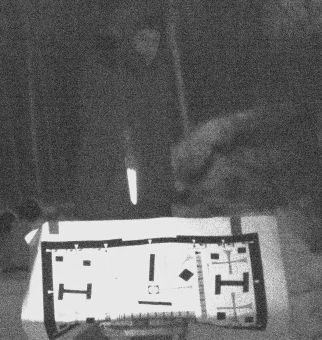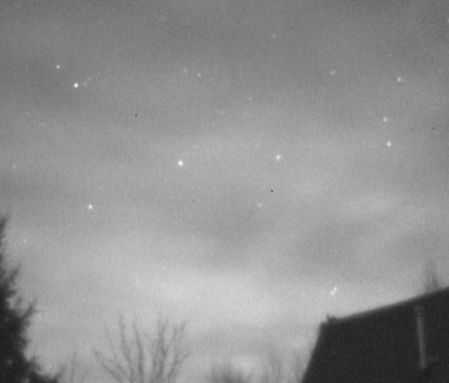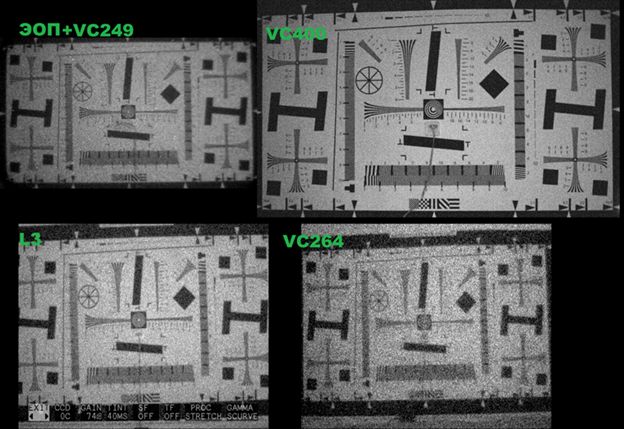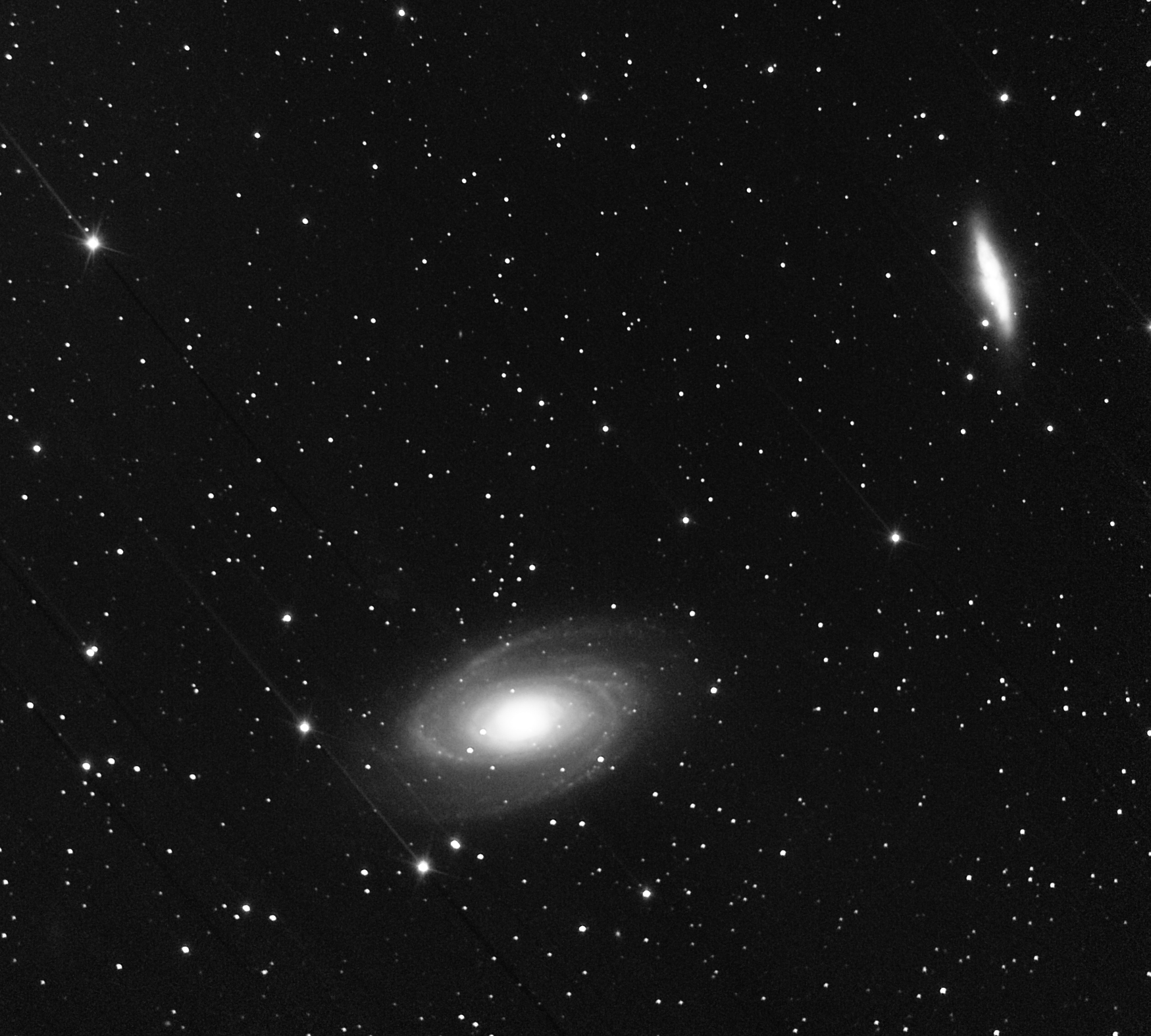How do different cameras and devices see at night?
There are a fairly large number of options to see at night. This is either a night-vision device, or a thermal imager, or a night-time sight with illumination, or maybe a camera with electronic multiplication by EMCCD. Unfortunately, not all cameras and devices are always at hand at the same time, and they usually cannot be compared with each other.
Fortunately, we were lucky, and we had such an opportunity. Moreover, it was lucky that the weather allowed us to recreate reference conditions for conducting comparative tests. There was no moon, the sky was clear, and it was only necessary to travel out of town, away from artificial lighting.
So, what did we have with us:
1.1 image intensifier tube - a third-generation electron-optical converter. The best of all devices such as image intensifier tubes that have been encountered. It is very difficult to create conditions under which he does not see anything. Image intensifier resolution 68lin / mm. The maximum spectral sensitivity should be around 800nm. The image intensifier is docked with a VC249 camera based on a low-noise sensor. The camera resolution is much higher than the resolution of the image intensifier tube, so the camera does not affect the result.
1.2 VS320 is a short-range infrared (SWIR) camera with a sensitivity in the spectrum range from 0.9 to 1.8 microns. The spectral sensitivity is almost flat. Resolution 320x256, size of the photosensitive element 25h25mkm.
1.3 VC400 is a “normal” camera of the visible range based on a silicon structure. “Normal” in quotation marks, because it is a camera for conducting astronometric observations with backlight. Resolution 2000x2000, the size of the photosensitive element more than 10 microns. The maximum spectral characteristics in the region of 550nm.
All cameras are designed and manufactured in Russia, but this should not bother anyone, since the element base (with the exception of the image intensifier tubes) is quite imported.
Shooting conditions:
1. Date: the night from 8 to 9 January 2018.
2. Breadth about 58 degrees, about 31 degrees longitude.
3. Moonless starry night.
4. The permeability of the sky to 19v.v. (indirect assessment).
5. Illumination at ground level (more precisely, snow): 2.5nW / cm ^ 2 (or some conventional 4ml).
6. The exposure time of all devices is 40ms, which corresponds to a frame rate of 25Hz.
Immediately anticipating the questions regarding the illumination on the ground, we were already tormented with photometric values (suites, candelas ...), which do not allow comparing the cameras with each other, and therefore we mostly use radiometric or natural ones (like “starry night”, “full moon” ), in this case it is a starry night without the moon.
The scene was formed in a classic way: "night, street, lantern ..." and your humble servant with a table. Actually, since many have already been waiting for pictures, I do not consider it possible to delay.
In turn: here is a frame with an image intensifier tube:

Here is a frame with VS320 (SWIR):

And here is the VC400 (visible range)

Unfortunately, the angles of the field of view are different, but it was not possible to select all three fast lenses (about one) that would ensure the same field of view.
Many will wonder why this terrible flashlight is in their hands? In fact, this is not a flashlight, it is a very weak LED wrapped in fabric to provide a glow in all directions, and it is needed to confirm the short exposure time. The lamp lubrication on the frame corresponds to an exposure time of 40ms:

The absence of the moon is confirmed by the absence of shadow from objects.
And this is how larger objects look (in order of image intensifier, visible, IR)

Of the features that you can notice: the sky in the near IR range (up to 2 μm) is really very bright ...
Also, some might think that the VS320 in the near IR range does not see the stars, but they are out of focus in these frames, if you focus, then the stars quite visible to yourself:

There’s another interesting shot in the whole video:

The VS320 has a window in the near-infrared, but not in the visible range. Despite the fact that the VS320 camera is not a thermal imager (in the classical sense), its sensitivity is enough to notice the lighting from the cooling stove in the house.
For those who want to watch video from all channels simultaneously (in full hd format), it is available here .
For readers who are in the habit of considering everything in a very substantive way, there is video in the format 3000x1000 (non-standard video size), the video is not compressed and is a combination of sources without distortion (registration and SMS): here .
Separately, video from a VC400 visible-range camera at a frequency of 25Hz (exposure time 40ms) - here .
A small bonus for readers: a test chart with different cameras under "starry sky" lighting. The e3v L3 is the European standard for sensitivity. The camera sensor has a rectangular pixel of a large area (14x28 μm) and is an EMCCD sensor with electronic multiplication, each registered electron in the sensor is amplified 1000 times. Unfortunately, in Russia these cameras (L3) are no longer available (picture from the archive):

Source image without compression link .
It may seem that in all these shots and filming there is nothing unusual, the most low-level cameras. But for example, shots taken on low-level cameras in the same light.

And a link to the video (for sophisticated readers).
Thus, we were able to collect in one place the most sensitive, at the moment, instruments that can be seen quite qualitatively at night, and at the same time, the instruments work in albeit close, but different spectral ranges.
Well, small conclusions that probably need to be drawn. I would not want to impose anything on the readers, since in general everything is visible on the materials presented.
Well, in conclusion of this short article, since the camera of the visible range turned out to be astronomical, we could not deny ourselves the pleasure of shooting several beautiful objects (Newton’s telescope “accidentally” turned up (D = 200mm F = 1000mm)):
Orion Nebula:

cloud.mail.ru/public/DWxi/dTFJVY4MJ
and Galaxy M81:

cloud.mail.ru/public/HQPo/YW4oHZeom
On the Internet, there are very few comparative frames and videos, mostly video from just one camera. Many videos show shadows from the moon, which suggests that the night is far from dark. We hope that this short article will fill this gap, give some information on how these or those devices are seen at night.
Special thanks to those who provided equipment and cameras, who took us to the Niva where there is no electricity and artificial lighting, to my colleague with whom we collected, removed and processed it.
ps: when using these materials - a link to the article is required.
Fortunately, we were lucky, and we had such an opportunity. Moreover, it was lucky that the weather allowed us to recreate reference conditions for conducting comparative tests. There was no moon, the sky was clear, and it was only necessary to travel out of town, away from artificial lighting.
So, what did we have with us:
1.1 image intensifier tube - a third-generation electron-optical converter. The best of all devices such as image intensifier tubes that have been encountered. It is very difficult to create conditions under which he does not see anything. Image intensifier resolution 68lin / mm. The maximum spectral sensitivity should be around 800nm. The image intensifier is docked with a VC249 camera based on a low-noise sensor. The camera resolution is much higher than the resolution of the image intensifier tube, so the camera does not affect the result.
1.2 VS320 is a short-range infrared (SWIR) camera with a sensitivity in the spectrum range from 0.9 to 1.8 microns. The spectral sensitivity is almost flat. Resolution 320x256, size of the photosensitive element 25h25mkm.
1.3 VC400 is a “normal” camera of the visible range based on a silicon structure. “Normal” in quotation marks, because it is a camera for conducting astronometric observations with backlight. Resolution 2000x2000, the size of the photosensitive element more than 10 microns. The maximum spectral characteristics in the region of 550nm.
All cameras are designed and manufactured in Russia, but this should not bother anyone, since the element base (with the exception of the image intensifier tubes) is quite imported.
Shooting conditions:
1. Date: the night from 8 to 9 January 2018.
2. Breadth about 58 degrees, about 31 degrees longitude.
3. Moonless starry night.
4. The permeability of the sky to 19v.v. (indirect assessment).
5. Illumination at ground level (more precisely, snow): 2.5nW / cm ^ 2 (or some conventional 4ml).
6. The exposure time of all devices is 40ms, which corresponds to a frame rate of 25Hz.
Immediately anticipating the questions regarding the illumination on the ground, we were already tormented with photometric values (suites, candelas ...), which do not allow comparing the cameras with each other, and therefore we mostly use radiometric or natural ones (like “starry night”, “full moon” ), in this case it is a starry night without the moon.
The scene was formed in a classic way: "night, street, lantern ..." and your humble servant with a table. Actually, since many have already been waiting for pictures, I do not consider it possible to delay.
In turn: here is a frame with an image intensifier tube:

Here is a frame with VS320 (SWIR):

And here is the VC400 (visible range)

Unfortunately, the angles of the field of view are different, but it was not possible to select all three fast lenses (about one) that would ensure the same field of view.
Many will wonder why this terrible flashlight is in their hands? In fact, this is not a flashlight, it is a very weak LED wrapped in fabric to provide a glow in all directions, and it is needed to confirm the short exposure time. The lamp lubrication on the frame corresponds to an exposure time of 40ms:

The absence of the moon is confirmed by the absence of shadow from objects.
And this is how larger objects look (in order of image intensifier, visible, IR)

Of the features that you can notice: the sky in the near IR range (up to 2 μm) is really very bright ...
Also, some might think that the VS320 in the near IR range does not see the stars, but they are out of focus in these frames, if you focus, then the stars quite visible to yourself:

There’s another interesting shot in the whole video:

The VS320 has a window in the near-infrared, but not in the visible range. Despite the fact that the VS320 camera is not a thermal imager (in the classical sense), its sensitivity is enough to notice the lighting from the cooling stove in the house.
For those who want to watch video from all channels simultaneously (in full hd format), it is available here .
For readers who are in the habit of considering everything in a very substantive way, there is video in the format 3000x1000 (non-standard video size), the video is not compressed and is a combination of sources without distortion (registration and SMS): here .
Separately, video from a VC400 visible-range camera at a frequency of 25Hz (exposure time 40ms) - here .
A small bonus for readers: a test chart with different cameras under "starry sky" lighting. The e3v L3 is the European standard for sensitivity. The camera sensor has a rectangular pixel of a large area (14x28 μm) and is an EMCCD sensor with electronic multiplication, each registered electron in the sensor is amplified 1000 times. Unfortunately, in Russia these cameras (L3) are no longer available (picture from the archive):

Source image without compression link .
It may seem that in all these shots and filming there is nothing unusual, the most low-level cameras. But for example, shots taken on low-level cameras in the same light.

And a link to the video (for sophisticated readers).
Thus, we were able to collect in one place the most sensitive, at the moment, instruments that can be seen quite qualitatively at night, and at the same time, the instruments work in albeit close, but different spectral ranges.
Well, small conclusions that probably need to be drawn. I would not want to impose anything on the readers, since in general everything is visible on the materials presented.
- In the near infrared range (1-2 microns) the sky is clearly glowing, in various articles it is written about it, but in fact it is very difficult to find a video in the public domain. We clearly observed a heterogeneous, but stable structure of the glow of the sky, somewhat similar to the northern lights. Thanks to this glow, the near-infrared VS320 camera sees well at night. Unfortunately, the camera instance that we had had a low resolution, but the device proved to be worthy. Definitely, near-infrared cameras can be used to improve visibility.
- The third generation image intensifier tube really does its job and sees at night. Unfortunately, the resolution of 68lin / mm is not very large, but sufficient to navigate and find objects.
- The discovery is the possibility of silicon CMOS devices of the visible range, on the basis of which the VC400 camera is made, to compare and even surpass third-generation night vision devices by resolution.
Well, in conclusion of this short article, since the camera of the visible range turned out to be astronomical, we could not deny ourselves the pleasure of shooting several beautiful objects (Newton’s telescope “accidentally” turned up (D = 200mm F = 1000mm)):
Orion Nebula:

cloud.mail.ru/public/DWxi/dTFJVY4MJ
and Galaxy M81:

cloud.mail.ru/public/HQPo/YW4oHZeom
On the Internet, there are very few comparative frames and videos, mostly video from just one camera. Many videos show shadows from the moon, which suggests that the night is far from dark. We hope that this short article will fill this gap, give some information on how these or those devices are seen at night.
Special thanks to those who provided equipment and cameras, who took us to the Niva where there is no electricity and artificial lighting, to my colleague with whom we collected, removed and processed it.
ps: when using these materials - a link to the article is required.
